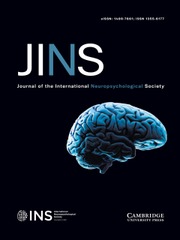Crossref Citations
This article has been cited by the following publications. This list is generated based on data provided by
Crossref.
Werheid, Katja
2011.
Neuropsychologische Diagnostik bei Alzheimerkrankheit im Frühstadium: Status quo und Zukunftstrends.
Zeitschrift für Psychiatrie, Psychologie und Psychotherapie,
Vol. 59,
Issue. 2,
p.
95.
Alichniewicz, Karolina K.
Brunner, Florian
Klünemann, Hans H.
and
Greenlee, Mark W.
2012.
Structural and functional neural correlates of visuospatial information processing in normal aging and amnestic mild cognitive impairment.
Neurobiology of Aging,
Vol. 33,
Issue. 12,
p.
2782.
Schecker, M.
Pirnay-Dummer, P.
Schmidtke, K.
Hentrich-Hesse, T.
and
Borchardt, D.
2013.
Cognitive Interventions in Mild Alzheimer's Disease: A Therapy-Evaluation Study on the Interaction of Medication and Cognitive Treatment.
Dementia and Geriatric Cognitive Disorders Extra,
Vol. 3,
Issue. 1,
p.
301.
Tiedt, H.O.
Lueschow, A.
Winter, P.
and
Müller, U.
2013.
Previously not recognized deletion in presenilin-1 (p.Leu174del.) in a patient with early-onset familial Alzheimer's disease.
Neuroscience Letters,
Vol. 544,
Issue. ,
p.
115.
Paajanen, T.
Hänninen, T.
Aitken, A.
Hallikainen, M.
Westman, E.
Wahlund, L.-O.
Sobow, T.
Mecocci, P.
Tsolaki, M.
Vellas, B.
Muehlboeck, S.
Spenger, C.
Lovestone, S.
Simmons, A.
and
Soininen, H.
2013.
CERAD Neuropsychological Total Scores Reflect Cortical Thinning in Prodromal Alzheimer's Disease.
Dementia and Geriatric Cognitive Disorders Extra,
Vol. 3,
Issue. 1,
p.
446.
Wolfsgruber, Steffen
Jessen, Frank
Wiese, Birgitt
Stein, Janine
Bickel, Horst
Mösch, Edelgard
Weyerer, Siegfried
Werle, Jochen
Pentzek, Michael
Fuchs, Angela
Köhler, Mirjam
Bachmann, Cadja
Riedel-Heller, Steffi G.
Scherer, Martin
Maier, Wolfgang
and
Wagner, Michael
2014.
The CERAD Neuropsychological Assessment Battery Total Score Detects and Predicts Alzheimer Disease Dementia with High Diagnostic Accuracy.
The American Journal of Geriatric Psychiatry,
Vol. 22,
Issue. 10,
p.
1017.
Stienen, Martin N.
Smoll, Nicolas R.
Weisshaupt, Rahel
Fandino, Javier
Hildebrandt, Gerhard
Studerus-Germann, Aline
and
Schatlo, Bawarjan
2014.
Delayed Cerebral Ischemia Predicts Neurocognitive Impairment Following Aneurysmal Subarachnoid Hemorrhage.
World Neurosurgery,
Vol. 82,
Issue. 5,
p.
e599.
Han, Ji Young
Seo, Eun Hyun
Yi, Dahyun
Sohn, Bo Kyung
Choe, Young Min
Byun, Min Soo
Choi, Hyo Jung
Kim, Shin Gyeom
Park, Shin Young
Kim, Jee Wook
Youn, Jong Chul
Jhoo, Jin Hyeong
Lee, Jung Hie
Kim, Ki Woong
Woo, Jong Inn
and
Lee, Dong Young
2014.
A normative study of total scores of the CERAD neuropsychological assessment battery in an educationally diverse elderly population.
International Psychogeriatrics,
Vol. 26,
Issue. 11,
p.
1897.
Beck, Irene R.
Schmid, Nicole S.
Berres, Manfred
and
Monsch, Andreas U.
2014.
Establishing robust cognitive dimensions for characterization and differentiation of patients with Alzheimer's disease, mild cognitive impairment, frontotemporal dementia and depression.
International Journal of Geriatric Psychiatry,
Vol. 29,
Issue. 6,
p.
624.
Heinzel, Sebastian
Liepelt-Scarfone, Inga
Roeben, Benjamin
Nasi-Kordhishti, Isabella
Suenkel, Ulrike
Wurster, Isabel
Brockmann, Kathrin
Fritsche, Andreas
Niebler, Raphael
Metzger, Florian G.
Eschweiler, Gerhard W.
Fallgatter, Andreas J.
Maetzler, Walter
and
Berg, Daniela
2014.
A Neurodegenerative Vascular Burden Index and the Impact on Cognition.
Frontiers in Aging Neuroscience,
Vol. 6,
Issue. ,
Schmid, Nicole S.
Ehrensperger, Michael M.
Berres, Manfred
Beck, Irene R.
and
Monsch, Andreas U.
2014.
The Extension of the German CERAD Neuropsychological Assessment Battery with Tests Assessing Subcortical, Executive and Frontal Functions Improves Accuracy in Dementia Diagnosis.
Dementia and Geriatric Cognitive Disorders Extra,
Vol. 4,
Issue. 2,
p.
322.
Rossi, Ariane
Burkhart, Christoph
Dell-Kuster, Salome
Pollock, Bruce G.
Strebel, Stephan P.
Monsch, Andreas U.
Kern, Christian
and
Steiner, Luzius A.
2014.
Serum Anticholinergic Activity and Postoperative Cognitive Dysfunction in Elderly Patients.
Anesthesia & Analgesia,
Vol. 119,
Issue. 4,
p.
947.
Zhang, William I.
Antonios, Gregory
Rabano, Alberto
Bayer, Thomas A.
Schneider, Anja
and
Rizzoli, Silvio O.
2015.
Super-Resolution Microscopy of Cerebrospinal Fluid Biomarkers as a Tool for Alzheimer’s Disease Diagnostics.
Journal of Alzheimer's Disease,
Vol. 46,
Issue. 4,
p.
1007.
Mistridis, Panagiota
Egli, Simone C.
Iverson, Grant L.
Berres, Manfred
Willmes, Klaus
Welsh-Bohmer, Kathleen A.
and
Monsch, Andreas U.
2015.
Considering the base rates of low performance in cognitively healthy older adults improves the accuracy to identify neurocognitive impairment with the Consortium to Establish a Registry for Alzheimer’s Disease-Neuropsychological Assessment Battery (CERAD-NAB).
European Archives of Psychiatry and Clinical Neuroscience,
Vol. 265,
Issue. 5,
p.
407.
Mayer, Daniel
Diwo, Angela
Imarhiagbe, Douglas
Erler, Silvia
Marksteiner, Josef
and
Kaufmann, Liane
2015.
Differentialdiagnostischer Nutzen der CERAD neuropsychologischen Testbatterie für Patienten mit leichter kognitiver Störung mit und ohne depressiver Symptomatik: Eine retrospektive Studie.
Zeitschrift für Neuropsychologie,
Vol. 26,
Issue. 2,
p.
131.
Umlauf, Ellen
Rappold, Eduard
Schiller, Bettina
Fuchs, Petra
Rainer, Michael
Wolf, Brigitte
and
Zellner, Maria
2016.
Careful neuropsychological testing reveals a novel genetic marker,GSTO1*C, linked to the pre-stage of Alzheimer's disease.
Oncotarget,
Vol. 7,
Issue. 26,
p.
39108.
Räling, Romy
Schröder, Astrid
and
Wartenburger, Isabell
2016.
The origins of age of acquisition and typicality effects: Semantic processing in aphasia and the ageing brain.
Neuropsychologia,
Vol. 86,
Issue. ,
p.
80.
Goettel, Nicolai
Mistridis, Panagiota
Berres, Manfred
Reinhardt, Julia
Stippich, Christoph
Monsch, Andreas U.
and
Steiner, Luzius A.
2016.
Association between changes in cerebral grey matter volume and postoperative cognitive dysfunction in elderly patients: study protocol for a prospective observational cohort study.
BMC Anesthesiology,
Vol. 16,
Issue. 1,
Lange, Catharina
Suppa, Per
Mäurer, Anja
Ritter, Kerstin
Pietrzyk, Uwe
Steinhagen-Thiessen, Elisabeth
Fiebach, Jochen B.
Spies, Lothar
and
Buchert, Ralph
2017.
Mental speed is associated with the shape irregularity of white matter MRI hyperintensity load.
Brain Imaging and Behavior,
Vol. 11,
Issue. 6,
p.
1720.
Dutzi, Ilona
Schwenk, Michael
Kirchner, Marietta
Bauer, Jürgen M.
and
Hauer, Klaus
2017.
Cognitive Change in Rehabilitation Patients with Dementia: Prevalence and Association with Rehabilitation Success.
Journal of Alzheimer's Disease,
Vol. 60,
Issue. 3,
p.
1171.




